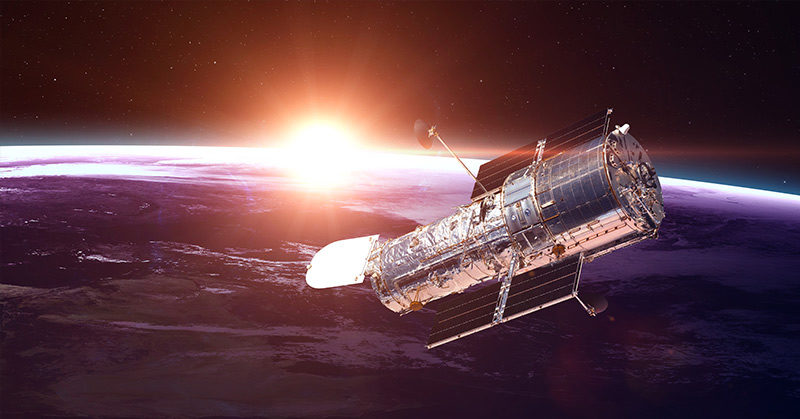Since the early days of space exploration, scientists have made many significant strides in their understanding of outer space. They’ve put men on the moon, found new planets and stars, and made conclusions about the inner workings of our solar system but one question remains unanswered: Is there life on other planets outside our solar system? Well, thanks to a new Hubble breakthrough, we may be closer to an answer.
While many scientists do believe that this could be the case, we have lacked any definitive proof to support that idea. Recently, however, scientists at NASA have made a major breakthrough using the space telescope Hubble, which could put them on track to finding the evidence they’ve been searching for.
Hubble Breakthrough
Using NASA’s Hubble Space Telescope, astronomers took advantage of a total lunar eclipse in order to detect ozone in the Earth’s atmosphere. The experiment was used as a proof-of-concept to simulate how astronomers and astrobiology researchers will look for evidence of life beyond our solar system [1].
The experiment had astronomers using the moon as a mirror to reflect sunlight that had passed through Earth’s atmosphere instead of looking at Earth directly. When that light was reflected back to Hubble, they were able to “see” earth’s atmosphere.
This is the first time a total lunar eclipse was captured at ultraviolet wavelengths from a space telescope. During the experiment, Hubble detected a strong spectral fingerprint of ozone, which absorbs some of the sunlight. Ozone, incidentally, is an important indication of the possibility of life.
Ozone = Life
Photosynthesis from plants over billions of years is responsible for Earth’s high oxygen levels and thick ozone layer. For this reason, scientists think that ozone or oxygen could be a sign of life on another planet, which is why they are referred to as biosignatures.
“Finding ozone is significant because it is a photochemical byproduct of molecular oxygen, which is itself a byproduct of life,” explained Allison Youngblood of the Laboratory for Atmospheric and Space Physics in Boulder, Colorado, lead researcher of Hubble’s observations [1].
Finding ozone in the skies a planet outside our atmosphere, however, does not guarantee that there is life on that planet. Youngblood explains that there are other spectral signatures that are required in addition to ozone to conclude that there is in fact life on that planet, and these signatures cannot always be seen with ultraviolet light.
Giada Arney of NASA’s Goddard Space Flight Center in Greenbelt, Maryland, a co-author of the science paper, says that the ingredients required for photosynthesis are elements that all habitable planets should have in common.
“Photosynthesis might be the most productive metabolism that can evolve on any planet, because it is fueled by energy from starlight and uses cosmically abundant elements like water and carbon dioxide,” she said [1].
Astronomers must search for a combination of biosignatures to determine whether there is life on a planet because ozone can also be produced without the presence of life when nitrogen and oxygen are exposed to sunlight.
Read: World record lightning ‘megaflash’ in South America — 440 miles long — confirmed by scientists
Searching for Life on Other Planets
To date, astronomers have been able to use Hubble to observe that atmospheres of gas giants planets that are several times the Earth’s mass (called super-Earths), that transit their stars. Transiting refers to when a planet passes across the face of its parent star.
During a transit, the planet is backlit by starlight, which filters through its atmosphere. Chemicals in the atmosphere leave their signature by filtering out certain colors of starlight, allowing scientists to determine which chemicals are present.
It has been much harder for scientists to figure out biosignatures for terrestrial planets that are the size of Earth because they are much smaller objects and their atmospheres are thinner. For this reason, researchers are going to need space telescopes that are much larger than Hubble to observe the atmospheres of these planets, and they will likely need to observe them for a much longer amount of time in order to build up a strong enough signal [1].
The Future of Space Exploration
We know that the makeup of the Earth’s atmosphere is a result of the planet being covered in plant life, which means that future observations of exoplanets could tell us whether or not there is life on distant worlds [2].
The technique for planetary observation used in this experiment will help scientists to narrow down which planets are more likely to support life, which will allow them to determine which planets should be the focus of future missions outside of our solar system.
Currently, NASA has a new telescope called the James Webb Space Telescope that is scheduled to launch in 2021. Webb will make similar kinds of measurements to Hubble in infrared light, and will have the potential to detect methane and oxygen in the atmospheres of planets outside our solar system [1].

